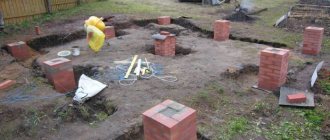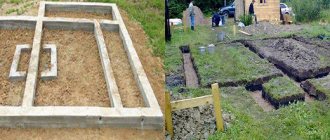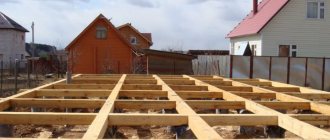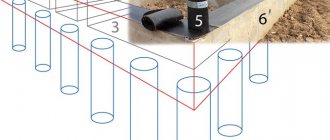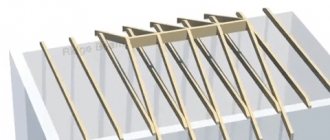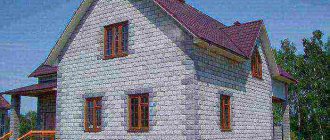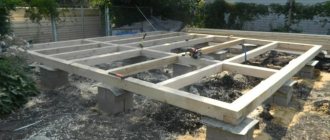A reliable and durable foundation is necessary for any building. In addition to strength qualities, many other requirements can be put forward for the foundation of a building. Among the variety of modern construction solutions, a rubble stone foundation occupies a special place. FoundationSpets.ru about what a rubble foundation is and how to fill it with your own hands.
Rubble foundation: what is it?
So, before considering the procedure for building a rubble foundation with your own hands, you should understand what this material is and what its features are.
By definition, rubble refers to natural stones suitable for constructing foundations for a building, with an irregular shape and almost parallel surfaces. Among the most famous species are:
- Limestone;
- Shell rock;
- Tuff;
- Cobblestone.
A rubble foundation, i.e., natural stone and cement, is usually created in a ratio of 90% to 10%. The size and shape of the stones are not a fundamental parameter and are selected individually for each construction site. Stones also differ in type: tile or chipped.
The best stone option for a rubble foundation
The tiled variation and bedded rock have proven themselves to be the best. When choosing stones, it is recommended to give preference to those that are as even as possible and have the most regular, smooth edges. This not only facilitates the installation process, but also allows you to make the visible above-ground part of the base as aesthetically pleasing as possible.
Most often, rubble is used to create a foundation for a bathhouse, thick-walled massive houses or multi-story mansions. Stones can be collected from the natural environment or purchased from relevant organizations.
Rubble concrete foundation diagram
Pros and cons of a rubble foundation
When considering a specific building material, you should also determine the pros and cons of its use. Despite its apparent simplicity and accessibility, this material has its own characteristics and requirements.
Among the main advantages of a rubble foundation, the following points can be noted:
- The material is natural and therefore environmentally friendly;
- The stone is durable, reliable and durable;
- Eliminates the need for additional decorative finishing;
- High moisture resistance, there is no need to provide waterproofing;
- Other building components can be added to the material;
- Possibility of erecting such a foundation on various types of soil;
- Ability to build various types of foundations.
There are also certain disadvantages that should be mentioned:
- The need to create a deep trench below the soil freezing level, as well as raising the foundation several decimeters above the ground level;
- Considerable cost of material, difficulties in delivery;
- The need for careful preliminary calculations;
- Duration of construction work.
Despite the existing advantages and disadvantages, this material has considerable popularity and is used in solving a wide range of construction problems.
Features of building a rubble foundation
In order for a strip-type rubble foundation to last for decades, you must follow some important rules
In order for a strip-type rubble foundation to last for decades, you must follow some important rules:
The depth of digging the trench should fall below the freezing level of the soil. Such deepening of the structure will make it more durable and will not allow low temperatures to affect the base of the circuit. More advanced craftsmen can use the technology of expanding the foundation to the bottom.
That is, you can start laying the base with a larger width and gradually achieve the desired one. The rubble stone contour must be mounted exclusively on top of a sandy and well-compacted cushion. In addition, you need to lay waterproofing from roofing felt on top, and on top - a small layer of mortar (about 15 cm). Although natural stone is not exposed to moisture, it is still better to install waterproofing for the base walls in the ground. For these purposes, roofing felt and mastic are used. If the walls of the trench under the foundation crumble, then it is better to make formwork before starting installation.
Otherwise, the soil that gets into the solution can completely destroy the entire structure later. For the first layer of the structure, it is better to use stones of approximately the same shape and only with smooth edges. This will protect the waterproofing layer from damage during operation. The distance between the stones should be about 5-7 cm. And all gaps are filled with mortar.
Important: the rubble foundation is installed in the likeness of brickwork, adjusting the stones with a mallet.
The arrangement of stones in the rows should be changed. That is, one row of material is laid with a spoon, the second row with a poke. To speed up the work, it is better to lay stones along the entire perimeter of the future foundation.
Still, their weight is significant, and it will be difficult to bring each of the stones to the point of work. When all the work on installing the base is completed, it is necessary to pour a layer of screed on top, which will act as a leveling base for masonry or installation of walls. Such a screed needs to be reinforced. When the entire foundation is ready, it must be dried for a month. And so that drying is not too fast, it is better to cover the entire structure with roofing material and periodically wet it. It is better to start forcing the walls after a year, when the strip base has settled and survived seasonal changes in the soil.
Important: rubble foundations can only be laid in the warm season. Because low temperatures force the bottle to take heat away from the solution. And this has a very negative impact on the entire structure as a whole.
Rate this publication:Loading…
- Date: 06/26/2015Rating: 22
Currently, a wide variety of foundation construction techniques are used for the construction of buildings and structures. The foundation can be made monolithic, columnar, or strip.
The material itself from which it will be made is also of great importance. Often the foundation can be made of large natural stone. This design is called rubble.
In addition to rubble, you can make a rubble concrete base. The construction technique differs somewhat. The rubble type of foundation is excellent for those areas where there is heaving soil and the depth of soil freezing is great.
Scheme of construction of a strip foundation.
This technology is recommended when arranging shallow structures.
Rubble strip foundations have been used for a very long time, but in recent years they have become even more popular. Very often it is used for the construction of wooden houses, including prefabricated ones. If we talk about the material itself, the stone has many advantages.
But the most important of them is that, unlike brick, it has higher strength, and in addition, it does not absorb moisture. Brick can gradually deteriorate and become unusable under the influence of moisture. Let's take a closer look at how a rubble strip foundation is laid and the main stages of manufacturing work.
Preparation
Organization of work during the construction of rubble foundations requires certain preparation. First of all, you will need to stock up on all the necessary tools and materials.
Materials needed include:
- Small crushed stone, which is used to eliminate voids left after masonry;
- Sand, which serves not only for arranging a sand cushion at the very bottom of the trench, but also for preparing a solution;
- Cement for preparing the solution, grade M400 is recommended;
- Rubble stone in the required volume, which does not exceed the total volume of the trench.
The following tools will also be useful for laying your own foundation:
- Several bayonet and shovel shovels;
- Container suitable for mixing the solution;
- Trowel;
- Construction level or its analogues;
- Plumb and tape measure;
- Tamping is mechanical or manual;
- Chisel;
- Pick;
- Sledgehammer;
- Hammer.
Not only preparatory activities are important, but also accurate calculations and measurements. They constitute half the success, and will determine the performance and characteristics of a rubble stone foundation, the construction of which will be discussed further.
Carrying out calculations
To prevent the construction from reaching a dead end, you need to calculate the required amount of rubble stone for the entire structure
To prevent the construction from reaching a dead end, you need to calculate the required amount of rubble stone for the entire structure. To do this, you need to know all the parameters of the future foundation, namely:
- Foundation width;
- Its height;
- The length of the structure on each side.
Now you need to multiply the length by the width of the entire foundation to calculate the area. After receiving the value, it must be divided by the average diameter of one bottle. For example, it will be equal to 35 cm. Thus, we find out how much rubble is required to lay the foundation in accordance with its area per row.
Reinforcement methods for strip foundations
Now you need to calculate the amount of stone needed in height by 1 m. To do this, we take 15 cm as the average thickness of the rubble. 100:15 = 7. Approximately 7 rows of rubble material will be required to lay one meter of foundation in height with an average rubble diameter of 35 cm.
It remains to calculate the total number of m3 of the designed base. To do this, we multiply its area by its height. Having received the value, we multiply it by 7. Thus, it has the amount of rubble necessary to lay out the area and volume of the base.
If it is planned to use rubble of various sizes for the construction of the foundation, then calculations can be made based on its tonnage. Thus, the average weight of stone per 1 m3 is 1.8 tons. Thus, having calculated the volume of your foundation, all that remains is to multiply it by 1.8. The result will be the weight of material required for the construction of the rubble strip circuit.
Do-it-yourself rubble foundation
The technology for building a rubble foundation with your own hands without specialists and additional equipment is as follows.
Construction of the trench
The first step is to mark the contours of the future trench on the ground. Do this using wooden pegs and ropes stretched between them. The width of the trench should be fifteen centimeters wider than the future walls. When you begin the process of digging a trench, observe and determine the degree of looseness of the soil and its composition. In case of significant shedding of soil from the walls of the trench, build temporary formwork from boards or other available materials.
First, we dig a trench and, if necessary, install formwork
After filling, these boards can be removed. Depending on the climate zone, the depth of the trench may vary. However, it must exceed the level of soil freezing, and therefore, as a rule, the depth of the trench is at least one and a half meters. In some specific situations, it may be necessary to use an excavator to carry out excavation work.
Preparing the pillow
In the prepared trench, the first layer will be a sand cushion. Place sand at the bottom of the trench in two layers, approximately thirty centimeters high. Then sprinkle a few centimeters of fine crushed stone on top. Next, pour water on top and compact the pillow.
For a better result, it is recommended to moisten and compact each layer separately.
A rubble foundation does not require the installation of a waterproofing layer, but if desired, you can use sheets of roofing material or its analogues.
We lay and compact a sand cushion at the bottom of the trench
Laying
Place natural cobblestones with as flat horizontal surfaces as possible in the first rows. They should become a strong support on which subsequent foundation stones and then the walls of the building will be laid.
Laying stone in a trench
Press the smooth stones of the first layers forcefully into the sand cushion until they become motionless, that is, they stop swaying and giving in. This also means that the pillow is tightly compressed, devoid of voids, openings and other undesirable formations that impair the strength qualities of the entire structure and base.
Direct the stones along the excavation for better load distribution. Do not lay stones crosswise under any circumstances; this is highly discouraged. If there are no suitable pieces in the batch of building materials, use a hammer, pick and chisel. Using these tools and assuming the role of a stonecutter, adjust the existing specimens to achieve the desired shape.
Further, during the process of laying stones, various defects will begin to form in one way or another in the form of depressions, openings, voids, etc. In this case, work with a tamper, and also add more small pebbles and crushed stone to eliminate unwanted voids. Additionally, use a sledgehammer for best results. The final step at this stage is to pour a layer of concrete solution, which was prepared in classical proportions.
Pouring a rubble concrete foundation
Laying the next rows
As mentioned in the previous paragraph, pour the first layer to a level of thirty to forty centimeters from the bottom of the trench. Using a similar principle, lay and fill each row. At the same time, install all subsequent layers directly into the not yet hardened solution of the previous row. Re-dress the stitches periodically.
Reinforcement. Additional stabilization and strengthening of the rubble foundation will never be superfluous, especially for high-height structures. For this purpose, use reinforcement or wire, paying special attention to the last layers of the structure.
Features and advantages of a rubble foundation
A strip foundation for a house, made of rubble, has a number of advantages compared to the usual reinforced concrete foundation
A strip foundation for a house, made of rubble, has a number of advantages compared to the usual reinforced concrete foundation. Some of the main ones are:
Reliability and solidity of the entire structure. A house built on a strip-type rubble foundation can last up to 150 years or more. The stone has excellent wear resistance. Thus, a tape-type base made of rubble is not exposed to winds, wear as a result of natural mechanical influences, resolution under the influence of ultraviolet radiation, etc. Low hygroscopicity of rubble.
As a result, the rubble structure is not able to absorb moisture, which makes such a base even stronger. By comparison, the usual reinforced concrete foundation, even if a vibrator is used when pouring the solution, is a porous structure that can absorb moisture during the rainy season or melting snow. And this, in turn, negatively affects the integrity of the entire structure. Attractive appearance of the structure, which does not require additional finishing. Comparative savings on building materials, but on the condition that the rubble deposits will be located in close proximity to the building site. The environmental friendliness of the material is additional a plus when constructing such a foundation.
Important: but a rubble foundation also has several disadvantages. Firstly, for its construction it is necessary to carry out painstaking and accurate calculations. And secondly, a rubble base requires a lot of time to lay it.
